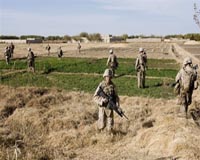| . |  |
. |
Arlington, Va. (UPI) Aug 23, 2010 The U.S. military plans to recruit 141,000 Afghan police and troops to build a force large enough to take over the nation's security. Military leaders say they'll meet that recruitment goal by October 2011 but the work of crafting a professional army out of a population with soaring illiteracy and attrition rates still lies ahead. The NATO training mission is responsible for training Afghan National Security Forces, which include national police and national army, to take over national security from U.S. and coalition troops. It is a daunting task that will extend next year's recruitment deadline, as NATO members try to rid Afghan forces of corruption, drug abuse, Taliban infiltrators and wage theft, said U.S. Army Lt. Gen. William Caldwell, commander of NATO training mission. U.S. President Barack Obama set a deadline of July 2011 to start pulling U.S. troops out of the country but, under Caldwell's timeline, Afghan forces won't have enough training by then to take over any large-scale security responsibility. Caldwell didn't provide any concrete dates for Afghan forces to take over the country's security during his Monday briefing from Afghanistan but said only that NATO leaders "are aware of the date" set by Obama and that developing a professional Afghan force will require a protracted commitment. NATO has exceeded this year's recruitment goals three months ahead of schedule with more than 57,000 force members and projects around 70,000 by the end of the year. High attrition rates, however, could hamper recruitment efforts. Attrition, or the number of security personnel who desert or drop out, reached 47 percent last month in the Afghan National Police, a level Caldwell called "unacceptable," although still lower than its peak of 70 percent. Some Afghan troops drop out to join insurgency groups or to take jobs with private security companies that promise better pay. In some areas of the country, 90 percent of Afghan security personnel have reported not receiving paychecks for months at a time, Caldwell said. NATO needs another 56,000 troops to meet its goal of 305,000 personnel but Caldwell set the goal of 141,000 recruits to account for attrition. NATO strikes that have mistakenly killed Afghan security forces in recent months may contribute to attrition rates. Since last November, NATO friendly fire has killed 32 Afghan security personnel. Three Afghan police were killed in a NATO operation Friday in the northern province Jawzjan. NATO troops have caused far fewer casualties by friendly fire this year, in part due to a U.S. directive that limits troops' ability to use weapons in the presence of civilians. But when incidents are given enough attention by the Afghan government or media, friendly fire casualties fuel resentment against NATO troops, said Michael O'Hanlon, a national security and defense policy expert at the Brookings Institute. "Every single time there is a tragedy, it sets things back," O'Hanlon said. NATO trainers are also combating dismal literacy rates, which average 14 percent to 18 percent across entry-level positions and have rendered security forces corrupt and incompetent, Caldwell said. NATO set up a mandatory literacy program now attended by 27,000 new recruits and plans call for another 100,000 recruits to complete the classes by next June. The program will put recruits at a third-grade reading level. "We're not trying to make high school graduates here," Caldwell said. "We start establishing accountability and that's critical. How do you expect a soldier to account for his weapon if they can't even read the serial number?" Training for Afghan forces costs the United States about $10 billion annually -- a sum that happens to equal Afghanistan's gross domestic product. After the October 2011 recruiting goals are reached, U.S. funding for Afghan security forces is expected drop to about $6 billion, O'Hanlon said. Sustaining Afghan security forces will remain an international responsibility for many years to come, and the United States will provide most of the funding, O'Hanlon said. "It's going to be a U.S. burden for a while," O'Hanlon said.
Share This Article With Planet Earth
Related Links News From Across The Stans
 US looks to Iraq strategy for Afghanistan
US looks to Iraq strategy for AfghanistanKabul (AFP) Aug 23, 2010 With the withdrawal of the final American combat brigade from Iraq, US commanders in Afghanistan are hoping to emulate a strategy used there as they step up the war against insurgents. The number of US and NATO soldiers in Afghanistan is set to peak at 150,000 in coming weeks following orders from US President Barack Obama for an extra 30,000 troops, a "surge" aimed at speeding the end of th ... read more |
|
| The content herein, unless otherwise known to be public domain, are Copyright 1995-2010 - SpaceDaily. AFP and UPI Wire Stories are copyright Agence France-Presse and United Press International. ESA Portal Reports are copyright European Space Agency. All NASA sourced material is public domain. Additional copyrights may apply in whole or part to other bona fide parties. Advertising does not imply endorsement,agreement or approval of any opinions, statements or information provided by SpaceDaily on any Web page published or hosted by SpaceDaily. Privacy Statement |